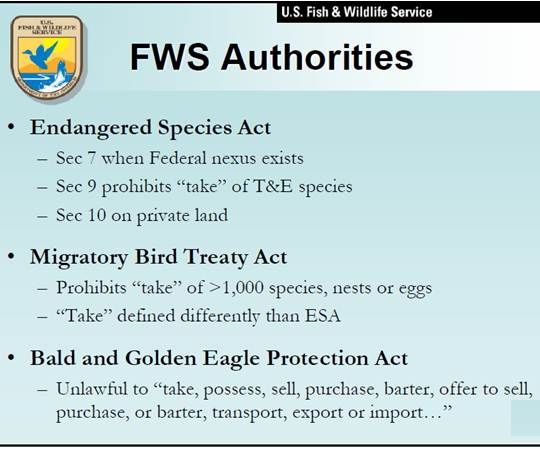Wind developers are moving toward solutions for dealing with birds, bats, and raptors, but they are going to pay a price for them. And the solutions likely will not quiet bird defenders.
The U.S. Fish and Wildlife Service (FWS) will release, perhaps as soon as April, its long-awaited final guidance on eagles. FWS’s guidance will define how wind developers are expected to comply with the Bald and Golden Eagle Protection Act (BGEPA). In conjunction with the Endangered Species Act (ESA) and the Migratory Bird Treaty Act (MBTA), the guidance will allow developers to proceed with building and provide the kind of certainty required by those who finance the billion dollar wind projects.
The guidance aims to protect avian and bat populations and habitats without inhibiting wind’s growth, according to FWS Senior Advisor David Cottingham. Whether it will be lenient enough to keep wind investors’ money flowing remains to be seen.
Harms of “significance,” in the guidance’s terminology, must be avoided if possible. But “takes” (the FWS term for deaths) of eagles will be allowed if there is “no net loss” of eagles (i.e., no compromise to the overall population).
Significance is said to exist when impacts have substantial consequences, are not transitory, and/or extend beyond the immediate vicinity of their occurrence.
If takes cannot be avoided, they must be minimized and mitigated.

Already poised to rage against the machines they call industrial-scale wind turbines, activists across the country will spring at this opportunity to condemn utility-scale wind, even though FWS considers this reasonable compromise unavoidable.
But, as the Director of Environmental Affairs for a major wind developer whose project was recently delayed by activists confided during a break in the American Wind Energy Association (AWEA) Project Siting Seminar, the site upon which his company wants to build is too rich in wind resources to abandon and the less-than-significant impacts of the project (by FWS’s definition), which the activists consider intolerable, can be readily mitigated.
There may be some disruption from the activists. It could, according to Dewey & LeBoeuf attorney and finance specialist John Renneisen, delay or complicate financing. But the disruption will not ultimately stop project financing.
Developers will do their due diligence and stay within the soon-to-be clearly established federal, state and local guidelines. Appropriate minimization measures and mitigation efforts will be identified and implemented, according to the soon-to-be-certain permitting rules. And financial institutions, which see investing in wind to be in their best interests and the best interests of their lenders and investors, will go forward with the certainty provided by the guidelines.
Outcries from local activists across the nation will ring loud for bird, bat and raptor losses and the compromise of habitats for whooping cranes, lesser prairie chickens and other avian species of concern.
Environmentalists, noted a seminar attendee who has had associations with both the Audubon organization and the wind industry, have long advanced their causes by capitalizing on such emotions. But, he added, activists who defend only their narrow local concerns are pushing their own impacts on climate change out into the wider world.
Such activists are often part of a broader anti-wind effort. But they create the opportunity to present the facts about birds, bats and raptors and the opportunity to contradict the misinformation they propagate, the unnamed attendee said. Nothing discredits loud voices as effectively as demonstrating that their arguments are false.
Studies of bats are progressing most rapidly, proving that bats’ presence can be identified and wind farm operations can be modified to accommodate them. There will be a price for such accommodations. It will compromise wind’s rapidly falling levelized cost. But it will lead to savings and growth.
Biologists studying harms done to migrating birds are learning three very important things. One is that mass mortality incidents such as a recent one in West Virginia can be caused by disorienting factors of all kinds, from bright lights in foggy weather to fireworks.
Another is that about three to four of every 10,000 bird deaths caused by human created factors are due to wind turbines.
The third is that smart siting can prevent such incidents. This last will add time and cost to development, but it will be a small price for such a big benefit.
Eagles and other raptors remain the toughest challenge. There are still many unknowns about their habitat and habits and their lives unfold slowly and independently, which slows research.
The American Wind Wildlife Institute (AWWI) and other wind organizations are driving research to better understand how to keep raptors away from wind farms and how to mitigate impacts when that cannot be done.
Our mutual goal, said Defenders of the Wildlife Senior Attorney Jason Rylander, is responsible renewable energy.



